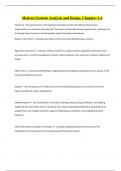Exam (elaborations)
Modern Systems Analysis and Design, Chapters 1-6
- Course
- Institution
Modern Systems Analysis and Design, Chapters 1-6 Analysis ️the second phase of the Software Development Life Cycle (SDLC) where system requirements are examined and organized. This phase includes determining requirements, studying, and structuring them based on interrelationships while elim...
[Show more]



